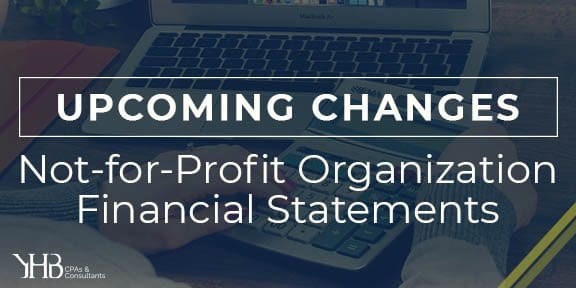Some changes in your year-end financial statements will be required that are designed to more clearly indicate your organization’s financial position as a result of a recent Financial Accounting Standards Board Accounting Standards Update (FASB ASU). The changes prescribed in Not-for-Profit Entities (Topic 958): Presentation of Financial Statements of Not-for-Profit Entities (ASU 2016-14) will affect substantially all NFPs, provide more relevant information about their resources and the changes in those resources to donors, grantors, creditors, and other financial statement users. We will review the changes in more detail with you, but here’s a brief overview.

Net Asset Classification
The new guidance will require your financial statements to present the amount for each of two classes of net assets on the face of the statement of financial position
- net assets with donor restrictions
- net assets without donor restrictions
The previous categories of temporarily and permanently restricted net assets are no longer presented, but are combined into a single category. To enhance readers’ understanding of the donor restrictions, footnote disclosures will be required to include the timing and nature of the restrictions, as well as the composition of net assets with donor restrictions at the end of the period. The disclosures will continue to show an analysis by time, purpose, and perpetual restrictions.
Learn how we help not-for-profits focus on their mission.
Underwater Endowments
As part of the change to classification of net assets, endowments that have a current fair value that is less than the original gift amount (or amount required to be retained by donor or by law), known as underwater endowments, will now be classified in net assets with donor restrictions, instead of the current classification in unrestricted net assets. Expanded disclosures will be required to include the following information:
- The original amount of the endowment
- The NFP’s policy relating to spending from these funds
- Whether that policy was followed
Board-designated Net Assets
At times, an NFP’s governing board may make designations or appropriations that result in self-imposed limits on the use of resources without donor restrictions, known as board-designated net assets; enhanced disclosure information will be required on the amounts and purposes of these designations. In addition, the placed-in-service approach will be required when releasing restrictions related to long-lived assets. The option to imply a time restriction and release the restriction over an asset’s useful life will no longer be permitted.
Information about Liquidity
NFPs will be required to disclose both quantitative and qualitative information about the availability of and how your NFP manages its liquid available resource to meet cash needs for general expenditures within one year of the balance sheet date. The goal of this change is to improve the ability of financial statement users to assess the NFP’s available financial resources and the liquidity of those resources.
Presenting Expenses
To make information about expenses more comparable and useful, all NFPs will be required to provide information about their operating expenses by both nature and function—on the face of the statement of activities, as a separate statement, or in the notes to the financial statements., supplemented with enhanced disclosures about the methods used to allocate costs among functions.
Investment Return
A net presentation of investment expenses against investment return will be required on the face of the statement of activities. External and direct internal investment expenses will be netted against the investment return. Disclosing the components of investment expense will no longer be required.
Statement of Cash Flows
NFPs can continue to present either the direct or indirect method of reporting operating cash flows. However, the presentation or disclosure of the indirect method reconciliation is no longer required if the NFP uses the direct method.
Effective Date and Transition
The amendments are effective for annual financial statements issued for fiscal years beginning after December 15, 2017, and for interim periods within fiscal years beginning after December 15, 2018.
This is just a quick synopsis of the changes we will be discussing with you at our upcoming symposium in June. If you have questions, please feel free to contact us any time.
About Claire

Claire graduated from West Virginia University with a Bachelor’s of Science degree in Accounting in 2009 and a Master of Professional Accountancy in 2010. She became a licensed CPA in 2012. Her career focus has been in the audit of nonprofit and governmental organizations.

